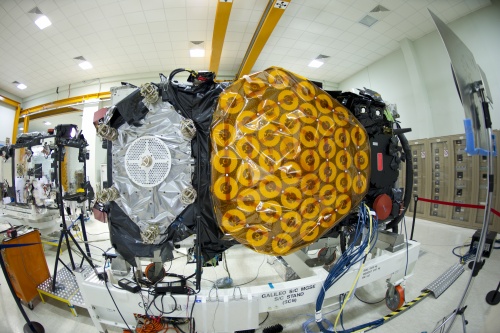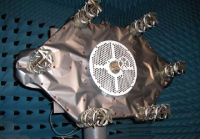If you wish to contribute or participate in the discussions about articles you are invited to contact the Editor
Galileo IOV Satellites: Difference between revisions
m (Article draft.) |
mNo edit summary |
||
| Line 1: | Line 1: | ||
{{Article Infobox2 | {{Article Infobox2 | ||
|Category= | |Category=GALILEO | ||
|Authors= | |Authors=D.Liberatore, Airbus Defence and Space | ||
|Level=Intermediate | |Level=Intermediate | ||
|YearOfPublication=2014 | |YearOfPublication=2014 | ||
| Line 8: | Line 8: | ||
}} | }} | ||
The In-Orbit Validation satellites are the first 4 spacecrafts of the Galileo Navigation Constellation, designed, procured and manufactured by Astrium under Prime leadership of the Ottobrunn site. These first four Galileo satellites will prove that the space and ground segments meet the mission’s requirements and will validate the system’s design in advance of completing the rest of the constellation. The aim of the IOV phase is to perform an in-orbit validation of the Galileo system using a reduced constellation of satellites, four being the minimum number for the provision of 3D positioning and timing at test locations. The results will be used as benchmarks for the operational phase and will represent the reference across the entire Galileo constellation once fully deployed. | The In-Orbit Validation (IOV) satellites are the first 4 spacecrafts of the Galileo Navigation Constellation, designed, procured and manufactured by Astrium under Prime leadership of the Ottobrunn site. | ||
These first four Galileo satellites will prove that the space and ground segments meet the mission’s requirements and will validate the system’s design in advance of completing the rest of the constellation. The aim of the IOV phase is to perform an in-orbit validation of the Galileo system using a reduced constellation of satellites, four being the minimum number for the provision of 3D positioning and timing at test locations. The results will be used as benchmarks for the operational phase and will represent the reference across the entire Galileo constellation once fully deployed. | |||
=Satellite design drivers= | =Satellite design drivers= | ||
The main satellite level design driver is the clock frequency stability, which is a critical requirement for the navigation mission in terms of service performance. The satellite architecture has been largely optimized | |||
::::[[File:IOV_sat.jpg|right|thumb|500px| Galileo IOV Satellite]] | |||
The main satellite level design driver is the clock frequency stability, which is a critical requirement for the navigation mission in terms of service performance. The satellite architecture has been largely optimized with regard to this requirement: | |||
* On the thermal control to achieve the required temperature stability on the relevant units; | * On the thermal control to achieve the required temperature stability on the relevant units; | ||
* On the attitude control to avoid solar flux onto the clocks radiator and ensure orbit long term stability and predictability; | * On the attitude control to avoid solar flux onto the clocks radiator and ensure orbit long term stability and predictability; | ||
* On the power subsystem to provide fully regulated bus | * On the power subsystem to provide fully regulated bus; | ||
* On the satellite units accommodation to avoid magnetic and micro-vibration effects on the clocks environment. | * On the satellite units accommodation to avoid magnetic and micro-vibration effects on the clocks environment. | ||
Another important requirement of the satellite is the in-orbit lifetime that is specified as 12 years. This places requirements on quality and shielding of the satellite units when accounting for the severe radiation environment for the MEO (Medium Earth Orbit) altitude. | |||
=Satellite architecture= | =Satellite architecture= | ||
The Galileo IOV spacecraft is composed of two modules, Payload (PAY) and Platform (PF). The Payload module provides the following functions: | The Galileo IOV spacecraft is composed of two modules, Payload (PAY) and Platform (PF). The Payload module provides the following functions: | ||
*Navigation (NAV); | *Navigation (NAV); | ||
| Line 39: | Line 41: | ||
==Payload Architecture== | ==Payload Architecture== | ||
===Navigation Architecture=== | |||
::::[[File:IOV_sat_ant.png|right|thumb|200px| Navigation Antenna (NAVANT)]] | |||
::::[[File: IOV_sat_sar.png|right|thumb|200px| SAR Antenna (SARANT)]] | |||
The main functions of the navigation payload are: | The main functions of the navigation payload are: | ||
* The provision of on-board timing signals; | * The provision of on-board timing signals; | ||
| Line 45: | Line 54: | ||
The timing signals are provided by high precision atomic on-board clocks, implemented as two (cold) redundant pairs: the Passive Hydrogen Maser (PHM) and the Rubidium Atomic Frequency Standard (RAFS). Both technologies are operated simultaneously, with the primary clock effectively used to generate the timing reference and the secondary clock used to support on-board monitoring of the primary clock (also allow clocks switch-over if required). | The timing signals are provided by high precision atomic on-board clocks, implemented as two (cold) redundant pairs: the Passive Hydrogen Maser (PHM) and the Rubidium Atomic Frequency Standard (RAFS). Both technologies are operated simultaneously, with the primary clock effectively used to generate the timing reference and the secondary clock used to support on-board monitoring of the primary clock (also allow clocks switch-over if required). | ||
The Galileo uplink signal is received via the Mission Antenna operating in circular polarisation (RHCP) | The Galileo uplink signal is received via the Mission Antenna operating in circular polarisation (RHCP), and then is routed to the Mission Receiver. | ||
The Navigation Signal Generation Unit receives the up-linked navigation data and generates in return the navigation signals in the appropriate format. | The Navigation Signal Generation Unit receives the up-linked navigation data and generates in return the navigation signals in the appropriate format. | ||
The 3 | The 3 navigation signals (E5, E6 and L1) are then routed to Solid State Power Amplifiers. The amplified signals are filtered, multiplexed and eventually routed to the navigation payload output section which distributes the high band (L1) and low band (E5/E6) signal power to each radiating element. | ||
===Search & Rescue Architecture=== | |||
The SAR payload is based on a transparent transponder receiving the uplink signal in the 406.0 - 406.1 MHz band and retransmitting it in the 1544.05 – 1544.15 MHz band. | The SAR payload is based on a transparent transponder receiving the uplink signal in the 406.0 - 406.1 MHz band and retransmitting it in the 1544.05 – 1544.15 MHz band. | ||
== Platform Architecture== | == Platform Architecture== | ||
Revision as of 10:55, 22 October 2014
| GALILEO | |
|---|---|
| Title | Galileo IOV Satellites |
| Author(s) | D.Liberatore, Airbus Defence and Space |
| Level | Intermediate |
| Year of Publication | 2014 |
The In-Orbit Validation (IOV) satellites are the first 4 spacecrafts of the Galileo Navigation Constellation, designed, procured and manufactured by Astrium under Prime leadership of the Ottobrunn site.
These first four Galileo satellites will prove that the space and ground segments meet the mission’s requirements and will validate the system’s design in advance of completing the rest of the constellation. The aim of the IOV phase is to perform an in-orbit validation of the Galileo system using a reduced constellation of satellites, four being the minimum number for the provision of 3D positioning and timing at test locations. The results will be used as benchmarks for the operational phase and will represent the reference across the entire Galileo constellation once fully deployed.
Satellite design drivers
The main satellite level design driver is the clock frequency stability, which is a critical requirement for the navigation mission in terms of service performance. The satellite architecture has been largely optimized with regard to this requirement:
- On the thermal control to achieve the required temperature stability on the relevant units;
- On the attitude control to avoid solar flux onto the clocks radiator and ensure orbit long term stability and predictability;
- On the power subsystem to provide fully regulated bus;
- On the satellite units accommodation to avoid magnetic and micro-vibration effects on the clocks environment.
Another important requirement of the satellite is the in-orbit lifetime that is specified as 12 years. This places requirements on quality and shielding of the satellite units when accounting for the severe radiation environment for the MEO (Medium Earth Orbit) altitude.
Satellite architecture
The Galileo IOV spacecraft is composed of two modules, Payload (PAY) and Platform (PF). The Payload module provides the following functions:
- Navigation (NAV);
- Search & Rescue (SAR).
While the Platform module includes dedicated subsystems for:
- Avionics (AVS);
- Propulsion (PROP);
- Telemetry Tracking & Command (TTC);
- Electrical Power (EPS);
- Thermal Control (TCS);
- Structure (STM);
- Harness (HAR).
Payload Architecture
The main functions of the navigation payload are:
- The provision of on-board timing signals;
- Reception and authentication of the up-linked mission data;
- Generation of the navigation message and broadcast via modulated L-band carrier.
The timing signals are provided by high precision atomic on-board clocks, implemented as two (cold) redundant pairs: the Passive Hydrogen Maser (PHM) and the Rubidium Atomic Frequency Standard (RAFS). Both technologies are operated simultaneously, with the primary clock effectively used to generate the timing reference and the secondary clock used to support on-board monitoring of the primary clock (also allow clocks switch-over if required). The Galileo uplink signal is received via the Mission Antenna operating in circular polarisation (RHCP), and then is routed to the Mission Receiver.
The Navigation Signal Generation Unit receives the up-linked navigation data and generates in return the navigation signals in the appropriate format. The 3 navigation signals (E5, E6 and L1) are then routed to Solid State Power Amplifiers. The amplified signals are filtered, multiplexed and eventually routed to the navigation payload output section which distributes the high band (L1) and low band (E5/E6) signal power to each radiating element.
Search & Rescue Architecture
The SAR payload is based on a transparent transponder receiving the uplink signal in the 406.0 - 406.1 MHz band and retransmitting it in the 1544.05 – 1544.15 MHz band.
Platform Architecture
Avionics Architecture
The Avionics subsystem provides the satellite on-board functions for decoding and processing of incoming TC, generation, encoding and storage of TM, electrical interface with the other satellite subsystems, overall HW and SW monitoring of the satellite, the Attitude and Orbit Control function, the On-Board Time (OBT) management.
Propulsion Architecture
Delta-V requirements are ensured by a mono-propellant hydrazine system operated in blow-down mode, composed of 2 identical branches each one equipped with a Latching Valve for isolation in case of failure and a Pressure Transducer for propellant gauging.
TC/TM Chain Architecture
The TC/TM chain involves two S-band antennas (circularly polarised in opposite directions) accommodated symmetrically on the satellite providing an omni-directional coverage with both the receive and transmit functions, the RF harness, two S-band transponders providing also the ranging functions.
Electrical Architecture
The satellite power is distributed to the electrical units via a 50V fully regulated bus providing constant supply voltage for optimal clock stability performance and minimisation of the variations of unit dissipation (w.r.t. the temperature stability requirements), which are relevant to the Galileo IOV satellite performances.
Thermal Architecture
The satellite units are maintained within their temperature limits via a SW controlled active heater system. This regulation allows to achieve a high accuracy in steady state condition and to minimise temperature control errors during thermal transients.
Mechanical Architecture
The structure architecture is based on a modular design, consisting in a Payload and Platform assemblies in order to allow parallel integration and optimization of MAIT activities and related schedule.
Harness Architecture
Functionally, the Galileo IOV harness is subdivided. The harness assemblies are mounted separately on their respective location and inter-connected via connector brackets to support the overall satellite modular integration concept.



